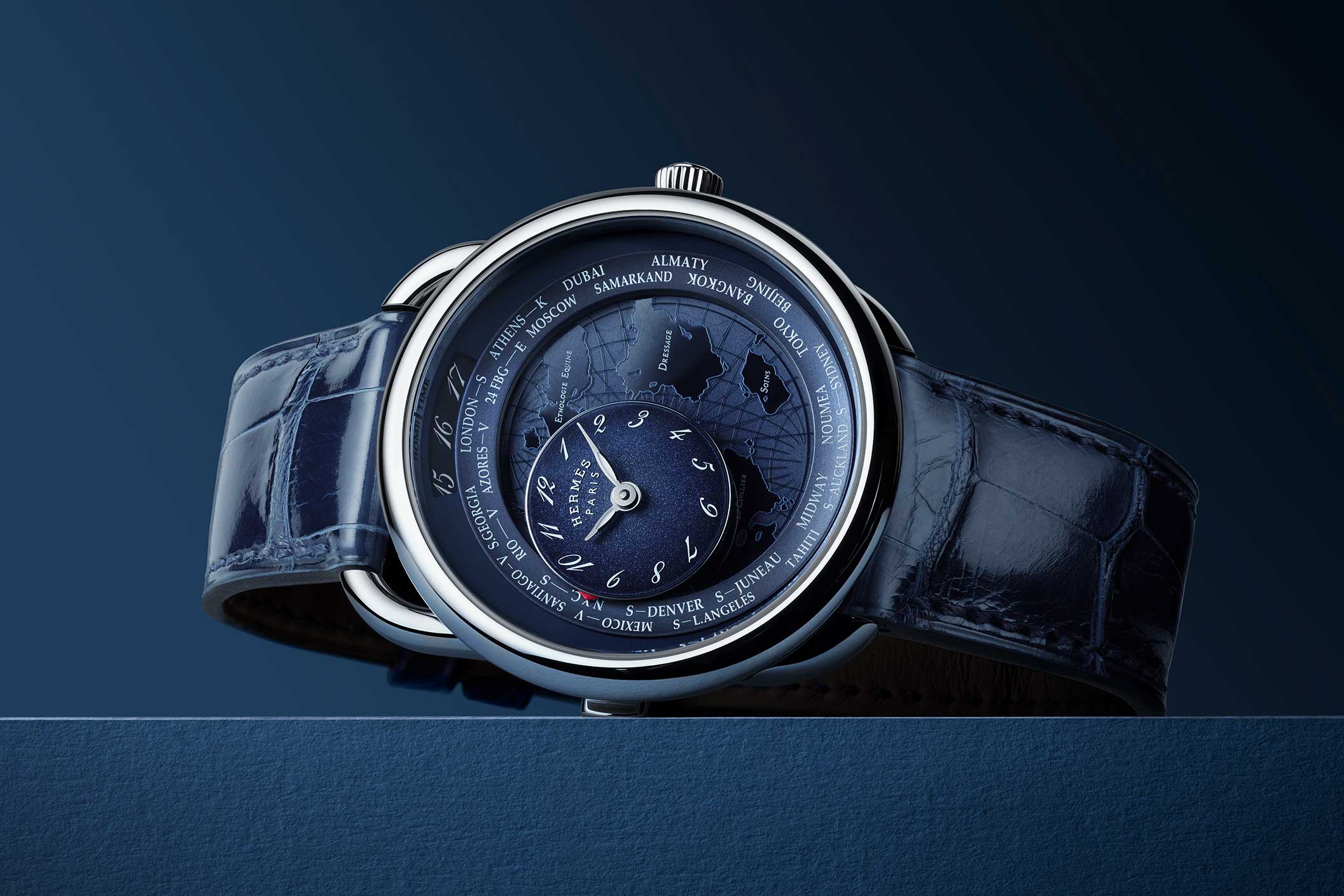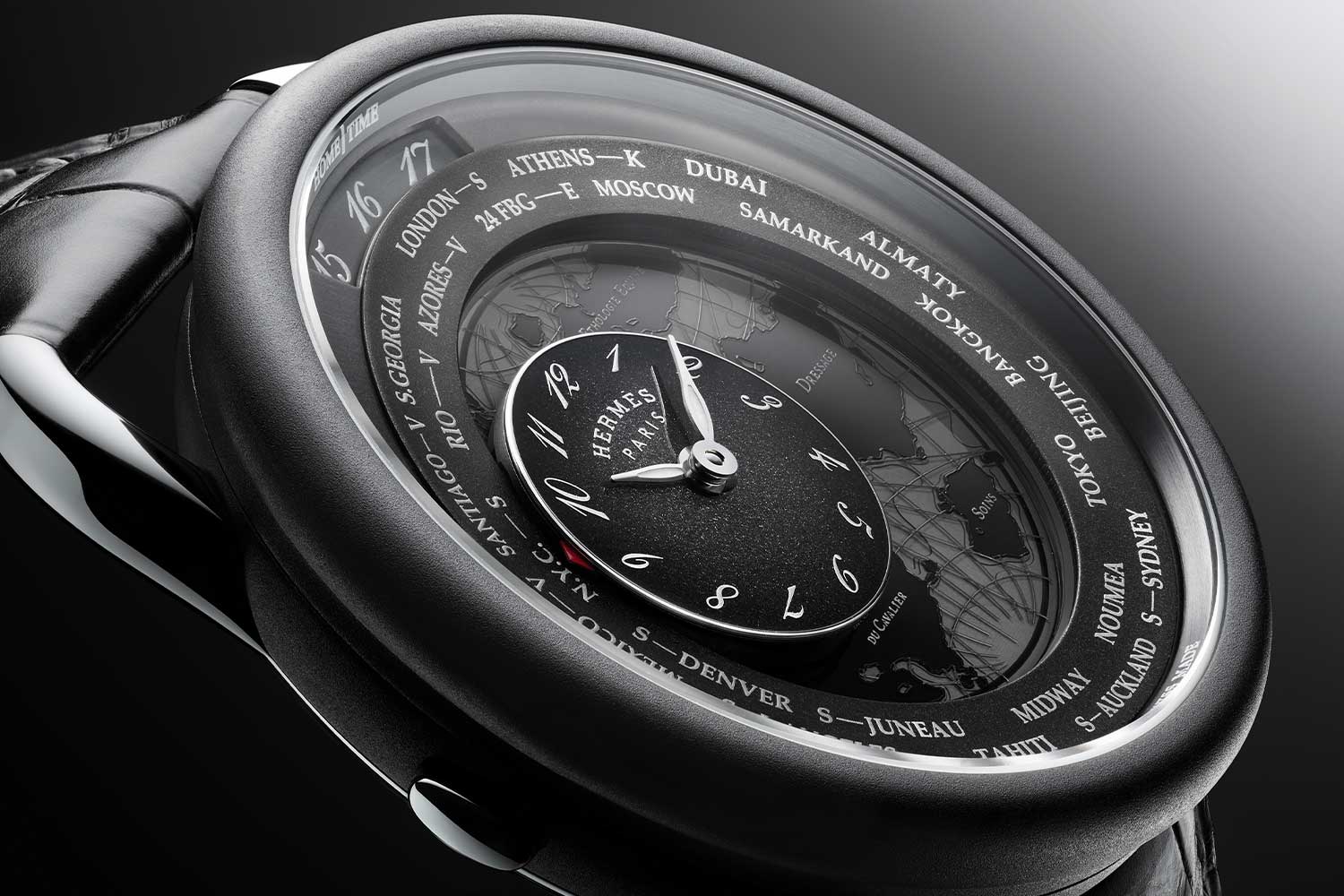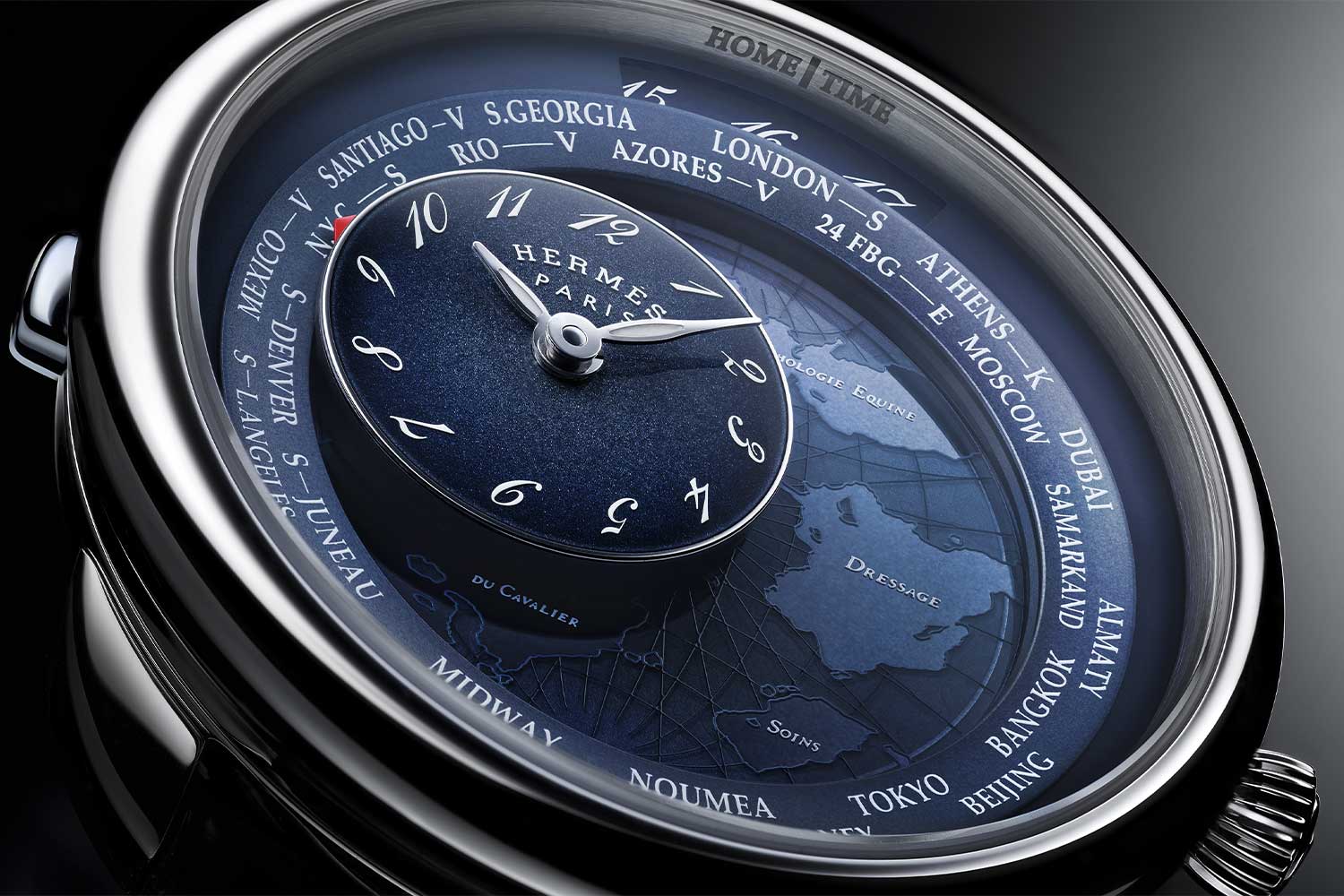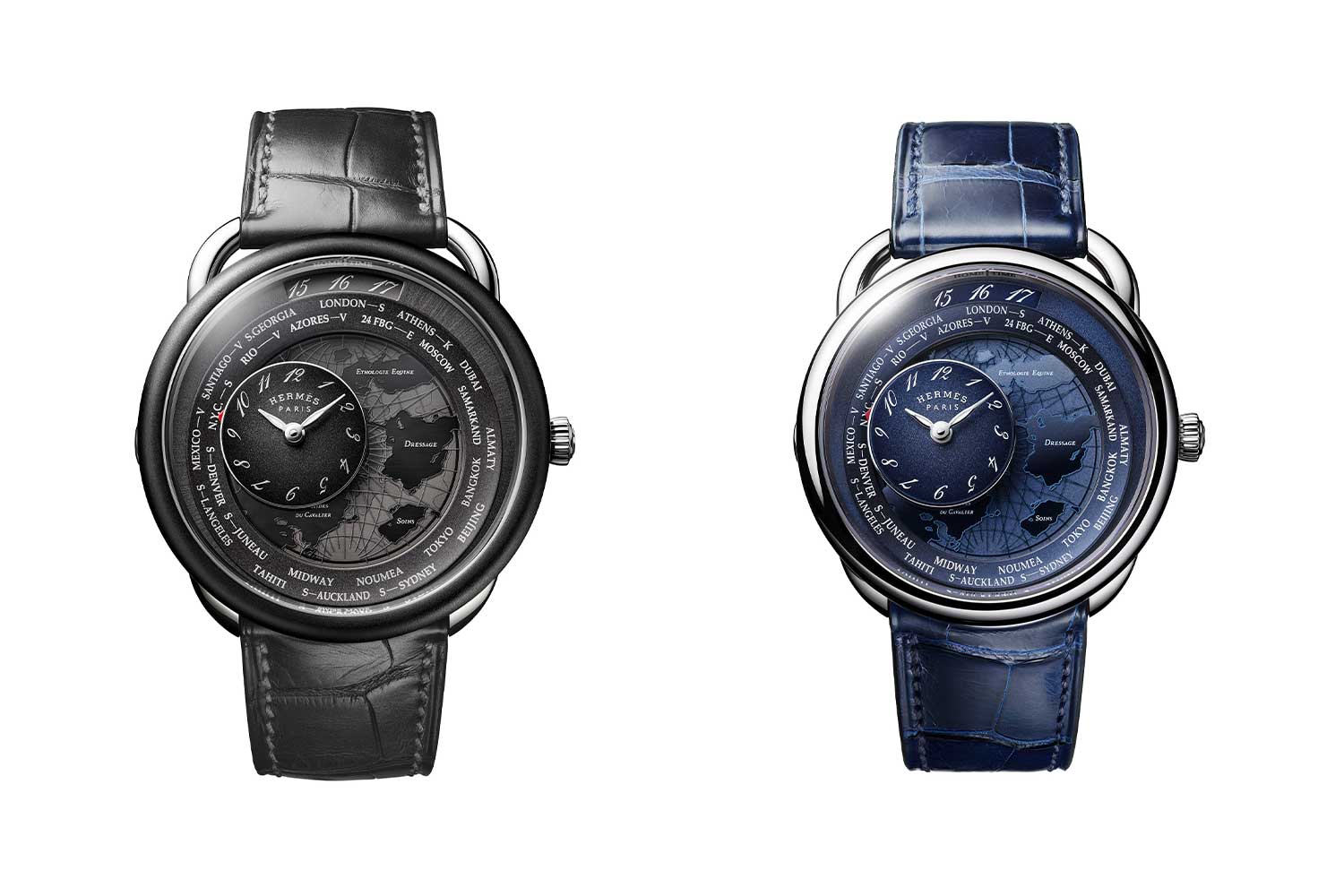Hermès
Introducing the Hermès Arceau Le Temps Voyageur
It was Louis Cottier who, at the age of 46, developed and filed a patent for the world time complication in 1931. The patented mechanism consisted of an inner dial with hands and 12 hour markers, a 24-hour ring and a second ring with cities printed on it. The way it worked was straightforward and highly intuitive. The 24-hour ring was synchronized to the central hour and minute hands. While the main hands turned clockwise, the 24-hour ring turned counterclockwise. Each of the 24 hours would align with the cities representing their respective time zones.
But the true genius of Cottier’s complication was that each time you traveled to a new city, you set your watch to local time ensuring that the 24-hour ring corresponded correctly to AM or PM hours. And then presto! You would be able to read the time in all 24 zones on the planet. To aid in clarity, Cottier would demarcate the day and night hours in different colored parts of the 24-hour ring and transform 12 noon into a sun icon and 12 midnight into a moon icon.

38mm Hermès Arceau Le Temps Voyageur in stainless steel (©JoelVonAllmen)
Says Philippe Delhotal, Artistic Director of La Montre Hermès, “We started this project three years ago, just about the time we launched the Arceau L’Heure De La Lune Models. And this new watch today is an invitation to travel, it is really a way for us to pay tribute to the importance that travel holds within RMS Hermès.
Delhotal continues, “We could say that this a new expression of the World Time, an alternate technical and aesthetic take on the complication. The starting point for us was really to consider how we can display time in motion. We wanted to have an interpretation which runs a bit counter to what you see in the industry. So we really pushed ourselves to take this horological challenge and take it on with a sense of playfulness that takes us around the globe.”

The subdial of the Hermès Arceau Le Temps Voyageur can be adjusted, using a pusher on the left side of the case, to make it move across the 24-cities listed to display your desired local time; home time is displayed using the aperture at 12 o'clock; home and local time must be synchronised first before local time can be displayed by using the crown on the right side (©JoelVonAllmen)
Fiction aside, the city-ring is very much real and lists 24 major cities, each representing one of the 24 major timezones. The subdial has a little red pointer incorporated with it, such that when the pusher on the left side of the case is pressed, the subdial moves to show you the time at that representative timezone.
When setting the watch, the wearer is first meant to use the pusher to move the subdial to a city from the city-ring that coincides with their home. Pulling the crown out to the second position now, and setting the time, will allow the wearer to sync the time on the subdial with that in the aperture at 12 o’clock, which is meant to indicate home time. Note that the home time indication is a 24-hour ring, so you would have to take into consideration AM/PM hours.
Once the crown is secured, using the pusher again, shift the subdial to a city on the city-ring that coincides with your local time. The timepiece will now show the time in the locality you are at right there and then. Traveling again to another city? Press the pusher again to your next destination and the subdial will travel this new timezone to display the correct time. The pusher moves the subdial in one-hour increments.

Timezones with summer and winter time differences have an extra position paired on the city ring to allow for correct time display (©JoelVonAllmen)
Explains Delhotal, “It is important to understand again that, when we take on a complication — a traditional complication — we always try to bring something different to it. Otherwise, we have no reason to pursue it. If we were to present the complication the same way as do the rest of the industry, that would not make sense to us. It is really key, for us, to bring a new idea to this multi-timezone concept. But we also kept ourselves constrained to create something that will be very easy and intuitive to use.
“We have a certain expertise established with the idea of the floating satellite, it is really an Hermès signature now. We used this approach, technically speaking, with the Arceau L’Heure De La Lune. It still took us three years to develop the traveling time module with Mr Mojon, but at least we have this experience, and it has become a real signature for us.
“What I personally love about the Arceau Le temps voyageur is that floating dial which gives a mystical feeling to the timepiece. I love this idea when you can’t really see what lies beneath and what makes it all work. It’s also about triggering our curiosity, you know? You’re thinking, ‘How is it showing the time? How is it floating over the imaginary planet?’ This is something I really love because it is really this wonderment that brings brings La Montre Hermès’ storytelling intentions to life.”

Hermès Arceau Le Temps Voyageur (©JoelVonAllmen)
Tech Specs
Hermès Arceau Le temps voyageur
Movement: Mechanical self-winding, Manufacture Hermès H1837 movement; 40-hour power reserve
Functions: Hours, minutes, second time zone with city names; home time
Case: 41mm platinum case (roughly 21.48g) and bezel in bead-blasted matt black DLC-treated grade 5 titanium (Ti 88%); 38mm steel case 316L; water-resistant to 30m
Dial:
41mm black version: “Planisphère d’un monde équestre” motif designed by Jérôme Colliard; galvanised dial, light grey transferred continent names and contours; sandblasted mobile counter with black gold-lacquered gradient rim; sandblasted black city flange; silver-toned powdered transferred city names | 38mm blue version: “Planisphère d’un monde équestre” motif designed by Jérôme Colliard; galvanised dial, blue transferred continent names and contours; mobile counter with blue-lacquered gradient rim; circular satin-brushed blue city flange; rhodium-plated hands coated with Super-LumiNova; black gold hands coated with Super-LumiNova
Strap: 41mm black version: Matt graphite alligator strap; black Barénia calfskin strap; slate grey Swift calfskin strap; 17mm pin buckle in black DLC-coated bead-blasted grade 5 titanium (Ti 88%) | 38mm blue version: Smooth sapphire blue alligator strap, navy blue Swift calfskin strap; 17mm pin buckle in 316L steel










